
Late Summer, 2018. On the road from Texas back to Oregon, somewhere in New Mexico. At a pit stop, we met Jenna and Padrick with their dogs Carnage & Tucker. They had passed us earlier, honking, waving, shouting and barking 'White Zombie!' They had seen the mishap on the 'Fastest Car' show, and were excited to see that the Zombie had been resurrected, fresh out of the paint booth (note socks to keep hood from rubbing).
The rebuild of White Zombie would not have been possible without Mitch Medford (Bloodshed Motors, Austin, Texas). Mitch provided the full facilities of the Bloodshed, did all of the major bodywork, all painting and so much more. Plasmaboy's longtime EV sidekick, Marko Mongillo's creativity and expert metalfab capabilites proved invaluable, too. Thanks also go out to the Bloodshed personnel who were all involved.






White Zombie was badly damaged from the accident during the four-way drag race while filming the Netflix show 'Fastest Car'. It was loaded up on the trailer and towed from the Mojave Desert in southern California along the Mexican border all the way to the Bloodshed in Austin, Texas. It remained there from September of 2017 until July of this year, when the extentive rebuilding process began.
To withstand the rigors of wheel-standing high torque launches at the drag track and to add safety aspects, in early 2010 the Zombie had been strengthened with thicker gauge body floor steel, stout subframe connectors and a welded-in six point roll bar (click 'Photos'). Though there was extensive body panel damage from this accident, the ridgid substructure from the A pillars rearward withstood the impact and was still straight and true.
The front end took the brunt of the impact. Both strut towers were pushed-over, the radiator core support was bent and twisted, and the unibody front subframe rails were tweaked. Using a frame straightener and exact measurements taken from Plasmaboy's other '72 1200 'Blue Meanie', it took several long days and nights to successfully reposition everything. Where needed, welding reinforcing steps were taken. Marko manipulated the under-hood compartment formed sheet metal back into shape.



As shown in the opening photo 'Phoenix Rising!', the driver's side fender was damaged beyond repair. After an exhaustive search, a good used fender was located. The passenger side fender was repairable. The front valance panel was crumpled badly, but a replacement panel could not be found. Marko's metal magic brought it back into shape.




The hood was tweaked and damaged, but a new one could not be found. Mitch was able to work wonders on the hood, as well as both fenders, both doors and the driver's side quarter panel.






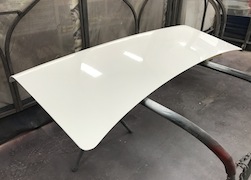
After test-fitting the fenders and hood several times, they were removed one last time. Then, along with the trunk lid and valance, they were painted off the car for best exterior and interior paint coverage and to allow protective coating/rustproofing to be applied to the inside of the fenders.



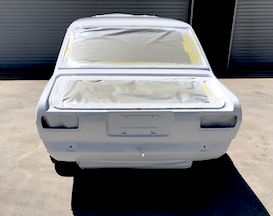



The full repaint included the under-hood area.
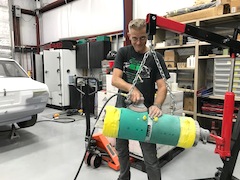
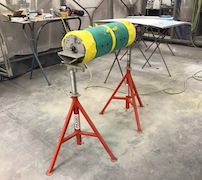




'Siamese 9' dual armature brushed series-wound. 538 hp, 1250 ft. lbs. from 0-2500 rpm. During the makeover, it was repainted 'Corvette Torch Red'.
Direct drive into Ford nine inch differential - no flywheel, clutch or transmission. Electric reverse.

Single piece all aluminum driveline from 'Inland Empire Drivelines'. NHRA required Driveline loop.



Dutchman heavy duty Street/Strip Ford nine inch rear axle setup with Strange aluminum differential housing, Detroit locker and 31 spline racing axles. Tall 3:25 gears, CalTracs and sticky drag radials take advantage of the electric motor's maximum torque at zero rpm for quick launches - 1.33 best 60 ft.
The 1972 Datsun 1200 economy car came standard with 12 x 4 inch steel wheels fitted with hubcaps. Major suspension and braking system upgrades in 2010 pushed the rim size to 15 inch to make room for substantially bigger brakes, 10.75 inch cross-drilled Brembo rotors pinched by Wilwood 4 piston calipers in front and 11.5 inch solid rotor Wilwood drag discs with 4 piston calipers in the rear (see 'Other Mods' 2010 section).
Both the front and rear wheels on the driver's side were damaged in the accident. The front wheel was especially troubling, as American Racing had made the pair of two-piece 15 x 6 wheels with a custom offset just for White Zombie. All four wheels were taken to 'Austin Wheel Repair' who restored the damaged wheels to like-new condition. The center grey spokes of all four wheels were repainted to be a matched set.











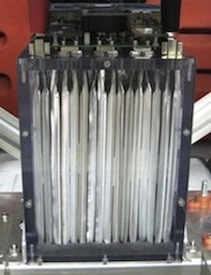

192 Dow Kokam lithium manganese nickel cobalt polymer cells configured at 2P96S make up the Zombie's 355V, 21.3 kWh high current battery pack. The UHP (ultra high power) cells are 3.7V, 30 ah nominal with a continuous discharge rate of 20C, have a 40C 10 second rating for a maximum of 1200 amps from each cell, and are configured in paralleled pairs so the battery pack can safely output 2400 amps. With a manufacture date code of 2007 they are now 11 years old and have been in service since 2010. All cells are still performing 'as new' and are well balanced. Once again White Zombie will see regular duty as a street car, and is scheduled for car shows and displays in 2019.
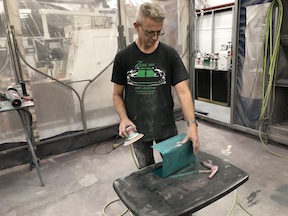


Zilla Z2k 2000 amp controller. During the makeover, like the motor, Mitch repainted the controller cover 'Corvette Torch Red'.


Meanwell high voltage model DC-DC feeding the same Thundersky 13.2V, 40 Ah lithium battery that's been in service for 8 years. Though on the smallish side at 20 amps output, the DC-DC now handles the 12V loads of the Zombie better than before, thanks to the full conversion of the lighting system over to super efficient LEDs.











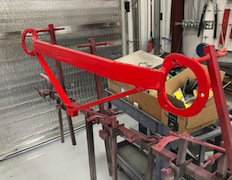





To further strengthen the Zombie's structure, a new strut tower brace was conceived, designed and built.
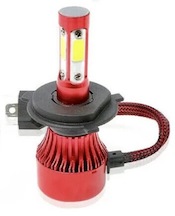



The Zombie's lighting system received a major upgrade, both in performance and in efficiency with a change-over to LEDs. In addition to much whiter-brighter headlights and brilliant side marker, taillights, parklights and turn signal lights, the total lighting system current draw dropped from 12.8 amps down to just 4.6 amps.
The car has always had high performance Bosch flat lense 7" headlights that use an H4 style halogen bulb. Now, in place of the H4 bulb, an H4 style 6000k LED element provides much whiter light that is also way brighter, while the power consumption has dropped from 55W per headlight on low beam, to just 20W. Its fan-cooled aluminum housing is anodized red, so it fits right in with the Zombie's 'red on white' motorbay look. Another fun aspect, is that even when off, the Zombie's headlights have a cool appearance, in that the LED's red frame is magnified in the highly polished Bosch reflector.


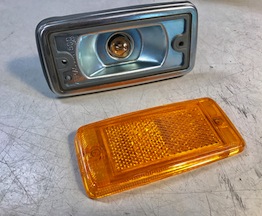
The left fender's sidelight was demolished, but a like-new one was found.




The sidelights were the most difficult to change over to LED. The early 70's Datsuns used a #90 bayonet style 7W bulb. It has a small diameter glass bulb but the same size BA15 metal base of the larger 1156 style brake/backup light bulb. Just one LED company offered the #90 style bulb, but was a 6000k color temp, and its cool-white light output ruins the color of both the amber-lensed front sidelights and red-lensed rear sidelights. A #90 style LED in a warm-white 3000k range simply could not be found, but a super bright smaller sized BA9 bayonet style LED bulb, typically used for dash gauge cluster backlighting was available in a warm-white color temp. All four #90 bulbs were removed from their respective sidelights. Their glass bulbs were then crushed, and the glass shards and cement were cleaned out from their B15 metal bayonet bases. The LED elements were desoldered and removed from their small B9 bayonet bases, then mounted and soldered into the B15 bases.



The color of the 5-SMD style LED-illuminated sidelights is a perfect match to the previous tungsten bulb-illuminated sidelights, but they are much crisper and brighter looking, while each sidelight consumes 1/7th the power - just 1 Watt instead of 7 Watts! This lowers the four sidelight's draw of 28 Watts down to just 4 Watts.


The US spec Datsun 1200 had amber-lensed combination marker/turn signal lights illuminated by a single dual filament 1157 bulb that draws 8 Watts for the marker light filliamp and 27W for the turn signal. The Zombie has been fitted with non-US spec 1/3 clear, 2/3 amber marker/turn signal lights with a 7W #90 BA15 bulb for the clear marker section and a 27W 1156 turn signal bulb. In this instance the previously mentioned 6000k cool-white #90 BA15 style LED, that was unsuitable behind colored lenses, is preferred to accentuate the clear section. A warm white 1156 style LED controlled by a solid state flasher provides brilliant instant on/off turn signal flashes.
The rear taillights of the US spec 1200 were three section affairs, with the tail/brake light having a red lense in the center section, the turn signal in the outer section also with a red lense, and the inner section a clear lense for the backup lights. As with the front marker/turn signals, the rear lenses were replaced with non-US spec lenses. They are tri-color with the turn signal section now amber. Warm-white 1157 style LEDs replace the bulbs in the tail/brake light assemblies behind the red section, warm-white 1156 style LEDs replace the bulbs in the turn signal section, and super bright 6000k cool-white 1156 style LEDs dramatically improve the backup lights.

The lighting improvements extended to the motor bay, with a hidden LED strip for fun nightime viewing


The 46 year old steering column's upper bushing at the steering wheel end was bad, allowing the wheel to wobble and feel loose. This imparted a tackiness to the driving experience. A new bushing was fabricated. Plasmaboy had a new late 90's era Momo leather & polished metal Italian steering wheel - still in its factory box, that had been on the shelf in the backyard EV shop for two decades. The funky Datsun B210 steering wheel (photo from 2001) that had been used for 24 years, was removed and replaced with the Momo. The bright metal body of the wheel and the bright metal door & window hardware work well with each other. Its amazing what a tight tolerance column bushing and a hand-crafted leather wheel can do for the driving experience!
2350 lbs.
White Zombie was offline in its wrecked condition and stored at Bloodshed Motors (Austin, Texas) from the Fall of 2017 (following the Netflix filming/racing incident) and through the first half of 2018. July through August, extensive work that included parts aquisition, frame-straightening, bodywork & paint and reassembly, resulted in a complete makeover that consumed the rest of 2018. It was the first time in 24 years it was absent from any public appearances.